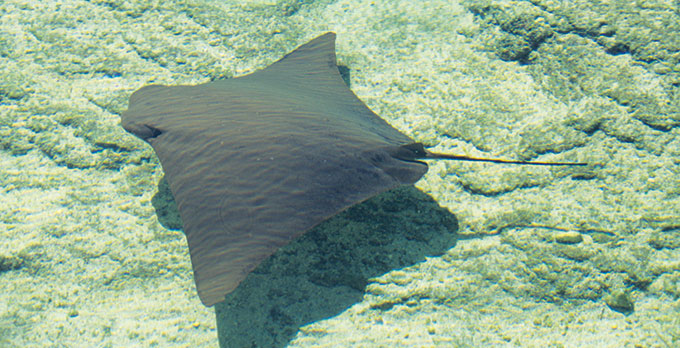The Case for the Cownose Ray
by Charlotte Hsu

Curious shoppers may notice a peculiar new offering at certain Wegmans seafood counters this summer: fillets of the cownose ray, a square-snouted species of stingray.
Tender and surprisingly beefy, cuts of the rose-hued meat can be strung onto kabobs bejeweled with pineapple chunks, or cooked Creole-style, swimming in tomato sauce and a jumble of spices.
If you’ve never had a stingray for dinner before, now may be the time to try one. But before you sample it, you should consider the story behind Wegmans’ decision to start selling the fish. Seafood is a complicated business.
Wegmans began offering the cownose ray at stores in Maryland and Virginia last year after learning that the kite-shaped predators were frustrating efforts to restore oyster fisheries in the Chesapeake Bay. Each summer, the rays converge on those waters to breed and dine on shellfish, posing a headache for fishermen raising and hunting oysters.
To help fight the pests, restauranteurs down south have added the ray to menus, experimenting with dishes ranging from breaded ray strips to plates of sushi featuring stingray rolls alongside farm-raised Chesapeake oysters.
With the encouragement of industry and state government officials, Wegmans decided to give the ray a try. Company chefs tested a few recipes—ray with porcini mushroom, ray with cracked pepper and basting oil—and found the results delectable. Soon after, Wegmans introduced the winged fish to customers under the moniker “Chesapeake ray.”
For the family-owned grocery chain, the new offering reflects a long-time devotion to sourcing seafood with the health of the oceans in mind. Conservationists have praised the retailer for practices such as pushing suppliers to adopt sustainable aquaculture techniques, and halting the sale of species including shark, marlin, and bluefin tuna that are endangered or fished using destructive methods. Steps like these have earned Wegmans a #2 ranking on a supermarket seafood sustainability scorecard that Greenpeace, one of the world’s leading environmental organizations, publishes.
Still, when it comes to the cownose ray, the story isn’t simple.
Groups marketing the winged fish as an eco-friendly seafood choice often assert that the species has experienced a population boom due to severe overfishing of the animals’ natural predators, sharks. The source of this information is a study on the subject that has received widespread media attention since results were made public in 2007.
The catch: Though the research appeared in Science, a premier, peer-reviewed journal, not all experts agree with the findings.
R. Dean Grubbs, an assistant scholar scientist at the Florida State University Coastal and Marine Laboratory, is among detractors. He points out that cownose rays, scientific name Rhinoptera bonasus, are not prolific in their reproduction. They take about eight years to mature, have an 11-month gestation period and typically produce a single pup in a year, Grubbs said.
He argues that claims of a huge jump in stocks of the fish are based on poor interpretation of data, and he co-signed a letter to the Virginia Marine Resources Commission last August stating as much.
“Many leading elasmobranch scientists…dispute the claims that cownose rays have dramatically increased in number in recent years,” the message said. “As this controversial notion is gaining acceptance, there is urgent need for a dedicated population assessment to determine the current status of cownose rays and safe catch levels.”
He and his co-signatories, including two researchers from the Virginia Institute of Marine Science and the president of Shark Advocates International, added that measures such as employing stockades or cages to protect commercial oyster beds—without killing rays—warrant further exploration.
Carl Salamone, vice president of Wegmans’ seafood department, says the Rochester-based grocer would be interested in helping to establish a well-managed cownose ray fishery once fishermen are more actively seeking out those fish.
But he notes that for now, Wegmans’ Chesapeake rays are actually by-catch, netted by accident by fishermen whose primary target is some other species.
Salamone is aware of the intricacies of the seafood trade. Since becoming Wegmans’ first corporate seafood manager in 1974, he has led the retailer’s efforts to source fish responsibly, sometimes pushing the company to stop selling products that customers have enjoyed for many years.
When queried about the controversy surrounding the cownose ray, Salamone responded that while he recognizes that different organizations often have divergent opinions about seafood sustainability, “what we do know is that for approximately three months out of the year, the rays enter the Chesapeake Bay and cause damage to the shellfish industry there.”
So consumers in the Buffalo area should be able to find ray fillets at select Wegmans stores over the next few weeks, until the rays leave the Chesapeake Bay for other waters.
Whether you decide to take one home or not, the debate over the species’ future illustrates the complexity of today’s seafood market.
Every cut of fish that reaches our dinner plates has a story. The lesson: We should think before we eat.
—charlotte hsu
blog comments powered by Disqus|
Issue Navigation> Issue Index > v10n31 (Week of Thursday, August 4) > Order Up! > The Case for the Cownose Ray This Week's Issue • Artvoice Daily • Artvoice TV • Events Calendar • Classifieds |









 Current Issue
Current Issue